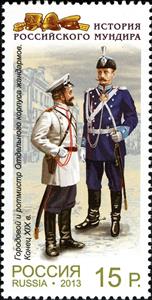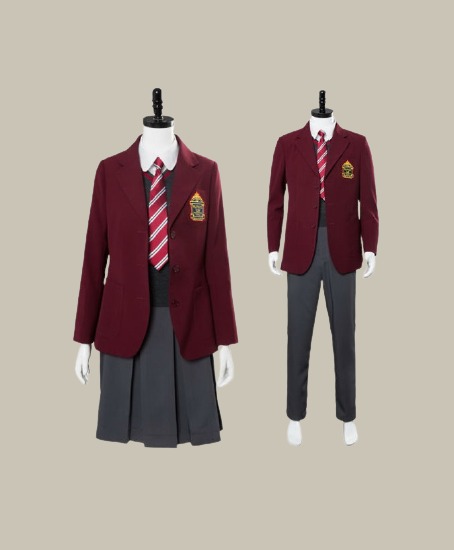Stamp: Policeman & Cavalry Captain Separate Gendarmerie (19th cent) (Russia 2013)
Policeman & Cavalry Captain Separate Gendarmerie (19th cent) (Russia 2013)
08 November (Russia ) within release History of the Russian Military Uniform goes into circulation Stamp Policeman & Cavalry Captain Separate Gendarmerie (19th cent) face value 15 Russian ruble
| Stamp Policeman & Cavalry Captain Separate Gendarmerie (19th cent) in catalogues | |
|---|---|
| Michel: | Mi:RU 1980 |
| WADP Numbering System - WNS: | WAD:RU 082.13 |
Stamp is vertical format.
Designer: S.Ulyanovsky.Also in the issue History of the Russian Military Uniform:
- Mini Sheet - History of the Russian Military Uniform face value 120;
- Stamp - Dragoon & Police Officer (1718) face value 15;
- Mini Sheet - Dragoon & Police Officer (1718) face value 120;
- Stamp - Policeman & Cavalry Captain Separate Gendarmerie (19th cent) face value 15;
- Mini Sheet - oliceman & Cavalry Captain Separate Gendarmerie (19th cent) face value 120;
- Stamp - Traffic Policewoman & Militia Sergeant Major (1934) face value 15;
- Mini Sheet - Traffic Policewoman & Militia Sergeant Major (1934) face value 120;
- Stamp - Senior Lieutenant & Major General of the Police (2012) face value 15;
- Mini Sheet - Senior Lieutenant & Major General of the Police (2012) face value 120;
Stamp Policeman & Cavalry Captain Separate Gendarmerie (19th cent) it reflects the thematic directions:
A military, also known collectively as an armed forces, are a heavily armed, highly organized force primarily intended for warfare. Militaries are typically authorized and maintained by a sovereign state, with their members identifiable by a distinct military uniform. They may consist of one or more military branches such as an army, navy, air force, space force, marines, or coast guard. The main task of a military is usually defined as defence of their state and its interests against external armed threats.
A uniform is a variety of costume worn by members of an organization while usually participating in that organization's activity. Modern uniforms are most often worn by armed forces and paramilitary organizations such as police, emergency services, security guards, in some workplaces and schools, and by inmates in prisons. In some countries, some other officials also wear uniforms in their duties; such is the case of the Commissioned Corps of the United States Public Health Service or the French prefects. For some organizations, such as police, it may be illegal for non-members to wear the uniform.
The police are a constituted body of persons empowered by a state with the aim of enforcing the law and protecting the public order as well as the public itself.This commonly includes ensuring the safety, health, and possessions of citizens, and to prevent crime and civil disorder Their lawful powers encompass arrest and the use of force legitimized by the state via the monopoly on violence. The term is most commonly associated with the police forces of a sovereign state that are authorized to exercise the police power of that state within a defined legal or territorial area of responsibility. Police forces are often defined as being separate from the military and other organizations involved in the defense of the state against foreign aggressors; however, gendarmerie are military units charged with civil policing.Police forces are usually public sector services, funded through taxes.


